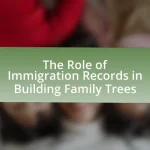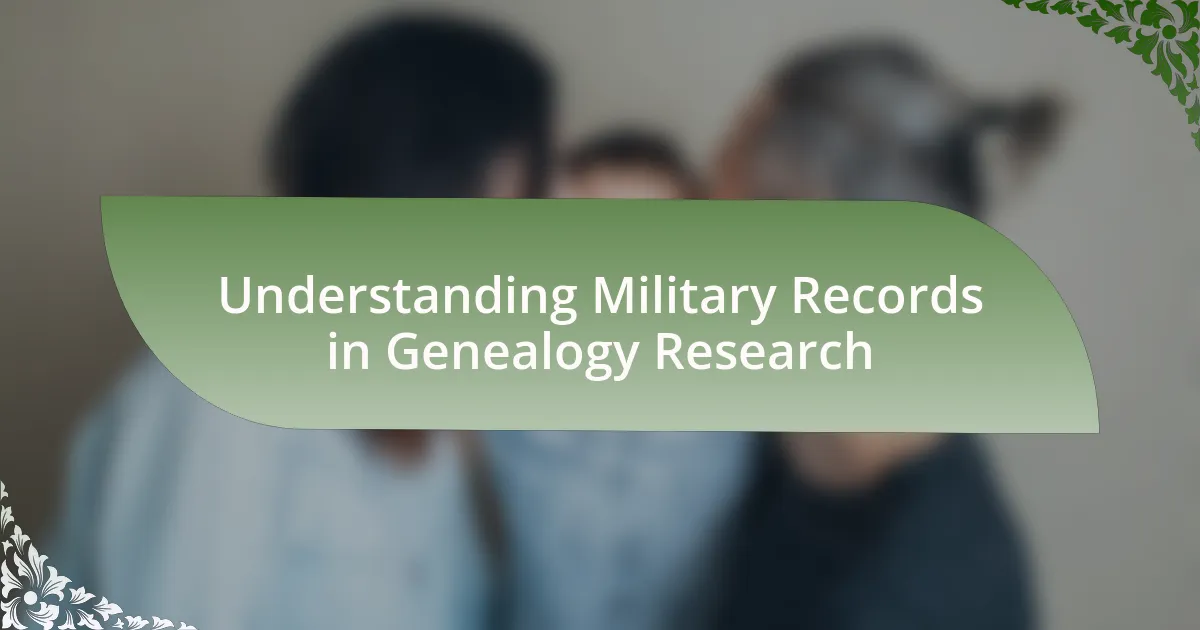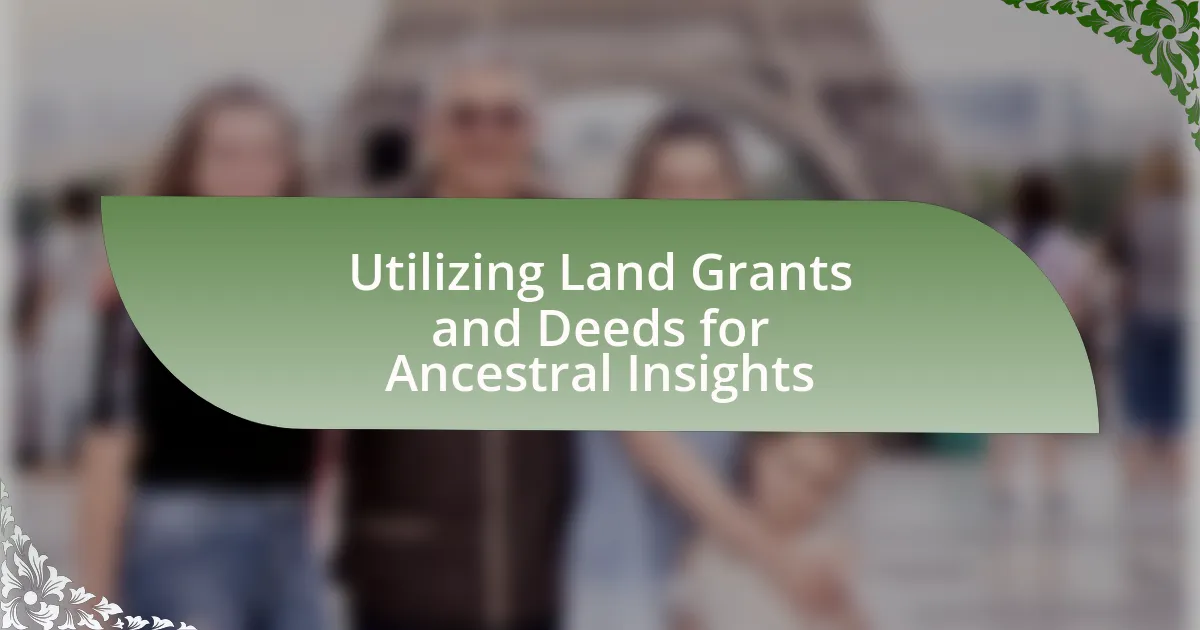Historical birth and death certificates are official documents that record vital life events and serve as essential resources for genealogical research, legal identification, and historical documentation. This article outlines the significance of these certificates, detailing the types of information they contain, their importance in tracing lineage, and the variations that exist across different time periods and jurisdictions. It also provides guidance on how to access these records, interpret their information, and verify their accuracy, while highlighting the role of historical context and family narratives in enriching genealogical research. Additionally, best practices for analyzing these certificates and the tools available for effective research are discussed, ensuring a comprehensive understanding of their value in uncovering personal and familial histories.
What are Historical Birth and Death Certificates?
Historical birth and death certificates are official documents that record the vital events of individuals, specifically their birth and death. These certificates serve as primary sources of information for genealogical research, legal identification, and historical documentation. They typically include essential details such as the individual’s name, date of birth or death, place of occurrence, and parental information for birth certificates. The existence of these documents dates back to the 17th century in Europe, with many countries implementing civil registration systems to maintain accurate records of vital events. This historical context underscores their significance in tracing lineage and understanding demographic trends over time.
Why are Historical Birth and Death Certificates important for research?
Historical birth and death certificates are crucial for research because they provide verified information about individuals’ identities, familial relationships, and demographic data. These documents serve as primary sources that help researchers trace lineage, understand population trends, and analyze historical events. For instance, birth certificates often include details such as date and place of birth, parents’ names, and sometimes even occupations, while death certificates typically record the date of death, cause of death, and burial information. This data is essential for genealogical studies, public health research, and social history analysis, as it allows for accurate reconstruction of family trees and demographic patterns over time.
What information can be found on these certificates?
Historical birth and death certificates typically contain essential information such as the individual’s full name, date of birth or death, place of birth or death, and the names of the parents or spouse. These details are crucial for genealogical research and legal documentation. For instance, birth certificates often include the child’s gender and the registration number, while death certificates may provide the cause of death and the informant’s details. This information is vital for tracing lineage and understanding family history.
How do these certificates contribute to genealogical research?
Historical birth and death certificates significantly contribute to genealogical research by providing essential information about individuals’ identities, familial relationships, and life events. These certificates typically include details such as names, dates of birth or death, places of occurrence, and parental information, which are crucial for constructing family trees and verifying lineage. For instance, a birth certificate can confirm a person’s parentage, while a death certificate may reveal the names of surviving relatives, thereby linking generations together. The accuracy of these documents is supported by their legal status and the requirement for official registration, making them reliable sources for genealogists seeking to trace ancestry and understand family histories.
What types of Historical Birth and Death Certificates exist?
Historical birth and death certificates primarily exist in two types: official government-issued certificates and church or religious records. Official government-issued certificates are typically created by civil authorities at the time of birth or death and include essential details such as the individual’s name, date of birth or death, and parents’ names. Church or religious records, on the other hand, are maintained by religious institutions and may contain similar information but can also include additional details like baptism or burial records. These records are crucial for genealogical research and legal purposes, as they provide verified documentation of an individual’s life events.
How do state and local records differ in their formats?
State and local records differ in their formats primarily due to the level of detail and the governing regulations that dictate their creation. State records often follow a standardized format mandated by state laws, which can include specific fields for information such as parents’ names, birthplaces, and dates, ensuring consistency across the state. In contrast, local records may vary significantly in format, reflecting the practices of individual counties or municipalities, which can lead to discrepancies in the information recorded and the layout of the documents. For example, some local records might include additional details like the attending physician’s name or local registration numbers, while others may omit certain standard fields found in state records. This variability can affect how researchers access and interpret historical birth and death certificates.
What variations exist in certificates from different time periods?
Variations in certificates from different time periods include differences in format, information included, and legal requirements. For instance, early birth and death certificates often lacked detailed personal information, such as parental names or cause of death, which became standard in later versions. Additionally, the design and language used in certificates evolved, reflecting changes in societal norms and record-keeping practices. For example, certificates from the 19th century may have used more formal language and less standardized layouts compared to those from the 20th century, which adopted more uniform formats and clearer guidelines for information collection. These variations are significant for genealogical research, as they can affect the completeness and accuracy of the data available for individuals from different eras.
How can one access Historical Birth and Death Certificates?
To access historical birth and death certificates, individuals can typically request them from the vital records office in the state or county where the event occurred. Each state has its own regulations and procedures for obtaining these records, often requiring a formal application, proof of identity, and sometimes a fee. For example, the National Center for Health Statistics provides guidelines on how to obtain these records, emphasizing that many states allow online requests, while others may require mail or in-person visits.
What are the primary sources for obtaining these certificates?
The primary sources for obtaining historical birth and death certificates include government vital records offices, local health departments, and state archives. Government vital records offices maintain official records of births and deaths, while local health departments often provide access to these records for their respective jurisdictions. State archives may also house historical records, including birth and death certificates, especially for events that occurred many years ago. These sources are essential for genealogical research and verifying personal history, as they contain vital information such as names, dates, and places of birth and death.
How do government archives and libraries facilitate access?
Government archives and libraries facilitate access by providing organized collections of historical documents, including birth and death certificates, and offering various services to assist users in locating and interpreting these records. They often employ trained staff who can guide researchers through the process, ensuring that individuals can navigate complex archival systems effectively. Additionally, many government archives and libraries digitize records, making them available online, which significantly enhances accessibility for users who may not be able to visit in person. This digitization process is supported by initiatives aimed at preserving historical documents while expanding public access, as seen in programs like the National Archives’ digitization efforts in the United States.
What online databases are available for historical records?
Several online databases are available for historical records, including Ancestry.com, FamilySearch.org, and MyHeritage.com. Ancestry.com offers extensive collections of birth, marriage, and death records, along with census data and military records, making it a comprehensive resource for genealogical research. FamilySearch.org, operated by The Church of Jesus Christ of Latter-day Saints, provides free access to a vast array of historical records, including vital records from various countries. MyHeritage.com also features a wide range of historical documents, including family trees and historical newspapers, which can aid in tracing lineage and understanding family history. These databases are widely recognized for their extensive collections and user-friendly interfaces, facilitating access to historical records for researchers and genealogists.
What are the steps to request copies of these certificates?
To request copies of historical birth and death certificates, follow these steps: First, identify the vital records office or agency responsible for maintaining the certificates in the relevant jurisdiction. Next, complete the required application form, which can often be found on the agency’s website. Then, provide necessary identification and any additional documentation that may be required, such as proof of relationship to the individual named on the certificate. After that, submit the application along with the applicable fees, which vary by location. Finally, wait for processing, which can take several weeks, depending on the agency’s workload and policies.
What information is typically required for a request?
A request for historical birth and death certificates typically requires the individual’s full name, date of birth or death, place of birth or death, and the names of the parents for birth certificates. This information is essential to accurately locate the specific records within archival databases or government repositories. Accurate details ensure that the request is processed efficiently and reduces the likelihood of errors in record retrieval.
How long does the process usually take?
The process of accessing and interpreting historical birth and death certificates usually takes between a few weeks to several months. This duration can vary based on factors such as the specific location of the records, the efficiency of the archive or agency handling the request, and the completeness of the information provided in the application. For example, some states may have online databases that expedite access, while others may require physical visits or lengthy processing times due to backlog or limited staff.
How can one interpret the information on Historical Birth and Death Certificates?
One can interpret the information on Historical Birth and Death Certificates by analyzing the specific details recorded, such as names, dates, places, and parental information. These certificates typically include the individual’s full name, date of birth or death, place of birth or death, and the names of parents, which provide essential context for genealogical research. For example, the date and place of birth can help establish timelines and geographical connections, while parental names can assist in tracing lineage. Historical certificates often reflect the cultural and legal practices of the time, which can further inform the interpretation of the data.
What common terms and abbreviations should be understood?
Common terms and abbreviations related to historical birth and death certificates include “DOB” for Date of Birth, “DOD” for Date of Death, “N/A” for Not Applicable, and “Informant,” which refers to the person providing the information on the certificate. Understanding these terms is crucial for accurately interpreting the data contained in these documents, as they provide essential context and clarity. For instance, “DOB” and “DOD” are fundamental for establishing timelines in genealogical research, while “Informant” can indicate the reliability of the information based on the informant’s relationship to the deceased.
How can understanding these terms aid in research?
Understanding the terms related to historical birth and death certificates aids in research by providing clarity on the specific information contained within these documents. Familiarity with terminology such as “vital records,” “registration districts,” and “informant” allows researchers to accurately interpret data, identify relevant records, and understand the context of the information presented. For instance, knowing that “vital records” refer to official documents that record life events enables researchers to focus their search on the correct types of documents, thereby increasing the efficiency and accuracy of their research efforts.
What are the challenges in interpreting older certificates?
Interpreting older certificates presents challenges such as faded text, archaic language, and inconsistent record-keeping practices. Faded text can obscure vital information, making it difficult to read names, dates, and places. Archaic language often includes terms and abbreviations that are no longer in common use, complicating understanding for modern readers. Additionally, inconsistent record-keeping practices across different jurisdictions and time periods can lead to discrepancies in data, such as variations in spelling or missing entries, which further complicates accurate interpretation. These factors collectively hinder the ability to extract reliable information from historical birth and death certificates.
How can context enhance the interpretation of these certificates?
Context enhances the interpretation of historical birth and death certificates by providing essential background information that clarifies the circumstances surrounding the events recorded. For instance, understanding the socio-economic conditions, cultural practices, and historical events of the time can reveal why certain details were included or omitted in the certificates. Additionally, contextual knowledge about the geographic location can explain variations in naming conventions or record-keeping practices. Historical records, such as census data or local histories, can further corroborate the information found in these certificates, ensuring a more accurate understanding of familial relationships and lineage.
What role does historical context play in understanding the data?
Historical context is crucial for understanding data from historical birth and death certificates as it provides insights into the societal, cultural, and legal frameworks that influenced record-keeping practices. For instance, variations in naming conventions, demographic information, and the reasons for recording certain details can be traced back to specific historical events or societal norms, such as the introduction of civil registration laws in the 19th century. This context allows researchers to interpret the data accurately, recognizing how factors like migration patterns, public health crises, and changes in family structure affected the information recorded. Understanding these elements enhances the reliability of conclusions drawn from the data, ensuring that interpretations are grounded in the realities of the time period being studied.
How can family stories and oral histories complement the information?
Family stories and oral histories can complement the information found in historical birth and death certificates by providing personal context and emotional depth that official documents lack. While birth and death certificates offer factual data such as dates and names, family narratives can reveal relationships, cultural practices, and individual experiences surrounding these events. For instance, oral histories may include anecdotes about the circumstances of a birth or the impact of a death on the family, enriching the understanding of the historical context. Research indicates that integrating oral histories with official records enhances genealogical research, as it allows for a more comprehensive view of family history (Source: “The Role of Oral History in Genealogy,” by Thomas W. Jones).
What are best practices for analyzing Historical Birth and Death Certificates?
Best practices for analyzing historical birth and death certificates include verifying the authenticity of the documents, understanding the historical context, and cross-referencing information with other records. Authenticity can be established by checking for official seals, signatures, and consistent formatting typical of the time period. Understanding the historical context involves recognizing the social, cultural, and legal frameworks that influenced record-keeping practices, such as variations in naming conventions or the impact of significant events like wars or epidemics on population records. Cross-referencing with other documents, such as census records, marriage licenses, and family trees, enhances accuracy and provides a more comprehensive view of an individual’s life. These practices ensure a thorough and reliable analysis of the certificates.
How can one verify the accuracy of the information found?
To verify the accuracy of information found in historical birth and death certificates, one should cross-reference the data with multiple reliable sources, such as government archives, census records, and other official documents. This method ensures that the information is consistent across different records, which is crucial for establishing its validity. For instance, if a birth certificate lists a date of birth, checking that date against census records or other birth registrations can confirm its accuracy. Additionally, consulting secondary sources like genealogical databases or historical societies can provide context and corroborate the information found in primary documents.
What tools and resources can assist in the analysis process?
Tools and resources that assist in the analysis process of historical birth and death certificates include digital archives, genealogical databases, and specialized software. Digital archives, such as the National Archives and state vital records offices, provide access to original documents and records. Genealogical databases like Ancestry.com and FamilySearch offer extensive collections of birth and death records, along with user-friendly search tools. Specialized software, such as genealogy management programs, helps organize and analyze data effectively. These resources enhance the accuracy and efficiency of research by providing comprehensive access to relevant historical documents.




